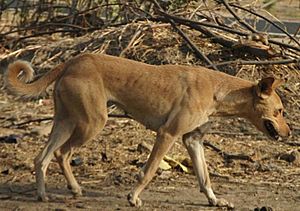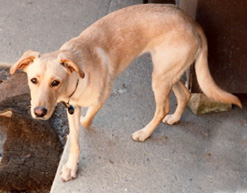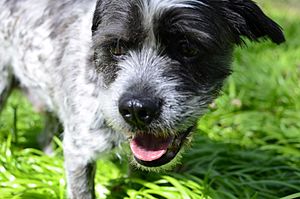Mixed-breed dog facts for kids
A mongrel, also called a mixed-breed dog or mutt, is a dog that does not belong to a specific, officially recognized dog breed. These dogs are usually not the result of planned breeding. Experts believe there are about 150 million mixed-breed dogs around the world.
While some people prefer the term "mixed-breed dog," many mongrels don't have any known purebred ancestors. It's important to know that crossbreed dogs are different from mongrels. Crossbreeds are also a mix of breeds, but they are created on purpose by humans. Even though mongrels were sometimes seen as less important than purebred dogs, they are often healthier. This is because they are less likely to have genetic health problems that can affect purebred dogs. Many dog lovers prefer mixed-breed dogs because of their unique qualities and good health.
Mixed-breed dogs show a lot of variety. But over many generations, without human control, they often develop similar body types and traits. These are known as landraces. Sometimes, people even develop these landraces into new breeds, like the Alaskan Husky.
Contents
What Are Mixed-Breed Dogs Called?
Mixed-breed dogs have many names, some of which are used more often than others.
Mixed-Breed vs. Crossbreed
Like mongrels, crossbred dogs do not belong to one recognized breed. However, crossbred dogs are often created on purpose by humans. This is called artificial selection. The term "mongrel" usually refers to dogs that developed naturally, without human planning.
"Mixed-Breed" or "Mongrel"?
In the United States, many people prefer the term "mixed-breed" over "mongrel." This is because "mongrel" can sometimes have a negative meaning. The idea that these dogs must be a mix of specific breeds might come from a misunderstanding of how dog breeds started. Most pure breeds were created by humans who selectively bred dogs to get certain looks or behaviors. Dogs that are not purebred are not always a mix of these defined breeds. Because of this, some experts and fans of these dogs still prefer the term "mongrel."
Fun Names for Mixed-Breed Dogs
There are many regional and slang terms for mixed-breed dogs. In the United Kingdom, "mongrel" is the official term. In North America, "mix" or "mixed-breed" are common. "Mutt" is also widely used in the United States and Canada. Some dog clubs that accept mixed-breed dogs call them "All American."
Here are some other fun names:
- In Hawaii, they are called poi dogs.
- In The Bahamas and Turks and Caicos Islands, they are known as potcake dogs.
- In South Africa, people sometimes say pavement special.
- In the Philippines, street dogs are often called askal, which means "street dog."
- In Puerto Rico, they are known as satos.
- In Brazil and the Dominican Republic, they are called vira-lata, meaning "trash-can tipper."
- A playful name for dogs of unknown ancestry is "Heinz 57" or "bitsa" (meaning "bits o' this, bits o' that").
Finding Out a Mixed-Breed Dog's Family Tree
It can be tricky to guess what breeds are in a mixed-breed dog's background.
Why It's Hard to Guess
Even experienced dog experts find it hard to guess a mixed-breed's ancestry. This is because mixed-breeds have much more genetic variety than purebreds. For example, two black mixed-breed dogs might carry hidden genes for a blond coat. Their puppies could then be blond, looking very different from their parents.
DNA Tests for Dogs
Since 2007, DNA tests have become available to the public. These tests claim to figure out the breed makeup of mixed-breed dogs. However, these tests have limits. They only cover a small number of the hundreds of dog breeds. Also, the same breed in different places might have different genetic profiles. The tests don't prove a dog is purebred. Instead, they show if a mixed-breed dog shares genes with certain purebreds. The American Kennel Club does not use DNA tests to determine a dog's breed.
Many newer dog breeds also share common ancestors, making them hard to tell apart genetically. For example, Labrador Retrievers and Newfoundland Dogs both came from the St. John's water dog, which is now extinct.
Health Benefits of Mixed-Breed Dogs
Mixed-breed dogs are often healthier than purebred dogs.
Hybrid Vigor
The idea of hybrid vigor suggests that dogs with varied ancestry are generally healthier than purebred dogs. When purebred dogs are bred over many generations, they often carry many of the same genes. Some of these genes can cause health problems. If a breed started with only a few dogs, its genetic variety might be small for a long time.
When humans choose certain dogs for new breeds, they can accidentally increase the number of copies of certain genes. This can make the new population more fragile at first due to less genetic variety. If a dog breed becomes popular and continues for hundreds of years, its diversity will increase over time. However, if desired traits in a breed are linked to genetic disorders, then breeding for those traits can also spread the disorder.
Mixed-breed dogs have more genetic variety because their parents' mating is more random. This means they are less likely to get certain genetic disorders. This is because there's a lower chance that both parents carry the same harmful hidden genes. However, some harmful genes are found across many different breeds. So, simply mixing breeds doesn't guarantee perfect health. Also, if two unhealthy dogs are bred, their puppies could inherit the worst traits from both parents. This is often seen in dogs from puppy mills.
Studies on Mixed-Breed Health
Several studies have shown that mixed-breed dogs have health advantages over purebred dogs.
- A German study found that "Mongrels require less veterinary treatment."
- Studies in Sweden found that "Mongrel dogs are less prone to many diseases than the average purebred dog." They also noted that "Mongrels were consistently in the low risk category" for death rates.
- Data from Denmark also suggests that mixed breeds live longer on average than purebreds.
- A British study showed similar results. However, a few pure breeds, like Jack Russell Terriers and Whippets, lived longer than mixed breeds in that study.
In one important study, researchers looked at the lifespan of 23,535 pet dogs. They found that for every body weight category, purebred dogs had a lower median age at death compared to mixed-breed dogs. The median age at death was 8.5 years for all mixed-breed dogs, and 6.7 years for all purebred dogs in the study.
A 2013 study found that mixed breeds live about 1.2 years longer than pure breeds on average. It also showed that heavier dogs generally have shorter lifespans.
Different Kinds of Mixed-Breed Dogs
Mixed-breed dogs can be grouped into a few main types:
- Mixes of Known Breeds: These dogs show traits of two or more specific breeds. A mix might have some purebred ancestors, or it might come from a long line of mixed-breeds. People often identify these dogs by the breed they look most like, such as a "Lab mix" or "Collie-Shepherd," even if their exact family tree isn't known.
- Generic Pariah Dogs: These are wild or feral dogs that have bred without human selection for many generations. The term "pariah dog" first referred to wild dogs in India. Now, it means dogs that are part of or descended from a population of wild or feral dogs. The Canaan Dog is an example of a recognized breed that came from pariah dogs. Pariah dogs are usually medium-sized and yellow to light brown. This might be what the ancestors of modern dogs looked like. DNA analysis shows that pariah dogs have a more ancient gene pool than modern breeds.
- Functional Breeds: These are dogs bred for specific tasks, even if their ancestors weren't purebred. They are chosen based on how well they perform. Examples include the Alaskan Husky, the Eurohound, and Pointer/Greyhound mixes called Greysters. These dogs compete in sports like skijoring. Sometimes, a functional breed like these can become an officially recognized breed over time.
Purebred dogs have breed names given to groups of dogs that look similar and have documented family trees. But recently, many owners of crossbreed dogs give them fun, made-up names. These names combine parts of the parents' breed names and are called "designer dogs." For example, a mix between a Pekingese and a Poodle might be called a Peekapoo. Another popular mix is the Goldendoodle, which is a cross between a standard poodle and a golden retriever.
Mixed-Breed Dogs in Sports
Until the early 1980s, mixed-breed dogs were usually not allowed in obedience or other dog sport competitions. However, groups like the American Mixed Breed Obedience Registry (AMBOR) and the Mixed Breed Dog Clubs of America (MBDCA) started creating events where mixed-breed dogs could compete. Now, there are more chances for all dogs to join in dog sports. Most dog agility and flyball groups have always allowed mixed-breed dogs to compete. Today, mixed-breeds have proven they are great at many performance sports.
In conformation shows, where dogs are judged on how well they match a breed standard, mixed-breed dogs usually cannot compete. Purebred dogs are judged against one specific breed standard. But mixed-breed dogs are very varied in their looks, like their coat, body shape, and ear type. It's hard to judge them by one standard. When conformation standards are used for mixed-breed dogs, like in MBDCA events, the judging is usually based on general traits like health, good structure, balance, and personality. The Kennel Club (UK) has a show called Scruffts, which is only for mixed-breeds. Dogs are judged on their character, health, and temperament.
Some kennel clubs, which focus on promoting purebred dogs, still don't allow mixed-breeds in their performance events. The AKC and the FCI are two such groups. While the AKC lets mixed-breed dogs earn their Canine Good Citizen award, mixed-breed dogs cannot enter AKC "all breed" events. However, through their "Canine Partners" program, mixed-breed dogs can sign up to compete in AKC Agility, Obedience, and Rally events.
Images for kids
-
DNA sequencing showed this mongrel dog to be a mix of Labrador retriever, Bull Mastiff, Chow, Australian Cattle Dog, Corgi, and Pit Bull.
-
Spinone Italiano-German Shepherd mixed-breed dog
-
Australian Shepherd-Border Collie mixed-breed dog
See also
 In Spanish: Perro mestizo para niños
In Spanish: Perro mestizo para niños










